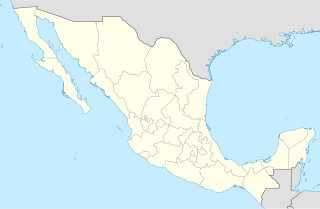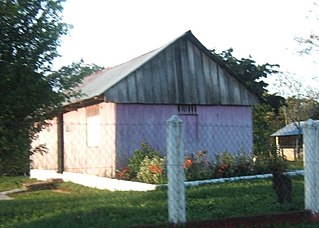
Comitán is the fourth-largest city in the Mexican state of Chiapas. It is the seat of government of the municipality of the same name.

The Mexican Riviera refers collectively to twenty cities and lagoons lying on the western coast of Mexico. Although there are long distances between these cities, they are often collectively referred to as the Mexican Riviera because of their many oceanfront resorts and their popularity among tourists. Cruise ships often visit three or four of these destinations on their longer cruises. In a 2005 interview Stanley McDonald, the founder of Princess Cruises, mentioned:
The call of the "Mexican Riviera" was coined by Princess Cruise Line. Now everyone refers to it as the Mexican Riviera. I believe that it really spoke to the quality and beauty of what people would see down there. We all know the French Riviera -- the Mexican Riviera was something we had in the western hemisphere.

Uxpanapa Municipality is a municipality lying in the southeastern part of the state of Veracruz, in Mexico. It is bordered by the municipalities of Jesús Carranza, Hidalgotitlán, Minatitlán, and Las Choapas in Veracruz, as well as Santa María Chimalapa in Oaxaca. It has an area of 2,600 km².

Totontepec Villa de Morelos is a small village and municipality, in the Sierra Mixe district of the Mexican state of Oaxaca. It is located some 1840 metres above sea level and some 326 km from the state capital, Oaxaca de Juárez. In spite of the Mixe influence, the toponym is Nahuatl in origin, meaning "hot hill".

The Mixe languages are languages of the Mixean branch of the Mixe–Zoquean language family indigenous to southern Mexico. According to a 1995 classification, there are seven of them. The four that are spoken in Oaxaca are commonly called Mixe while their two relatives spoken in Veracruz are commonly called "Popoluca", but sometimes also Mixe. This article is about the Oaxaca Mixe languages, which their speakers call Ayuujk, Ayüük or Ayuhk.

Santa Lucía del Camino is a city and its surrounding municipality located in the central part of the Mexican state of Oaxaca. It lies just 3 km east of the state capital city of Oaxaca, within the Oaxaca metropolitan area. It is part of the Centro District in the Valles Centrales region.

San Juan Bautista Coixtlahuaca is a small town and municipality located in the Mixteca Region of the State of Oaxaca, Mexico, and the center of the Coixtlahuaca district. The name, “Coixtlahuaca” means ‘plain of snakes’ in the Nahuatl language.

The Coatzacoalcos is a large river that feeds mainly the south part of the state of Veracruz; it originates in the Sierra de Niltepec and crosses the state of Oaxaca in the region of the Isthmus of Tehuantepec, flowing for 325 kilometres toward the Gulf of Mexico. Tributaries include El Corte, Sarabia, Jaltepec, Chalchijalpa, El Chiquito, Uxpanapa, and Calzadas. The merging of all these rivers creates one of the largest current flows in the entire region. Two-thirds of the streams are navigable.
Chacaltianguis is a municipality in Veracruz, Mexico. It is located in the south of the state of Veracruz. It has a surface of 557.69 km2. It is located at 18°18′N95°50′W.
José Azueta Municipality is a municipality in Veracruz, Mexico.
Juan Rodríguez Clara is a Municipality in Veracruz, Mexico. It is located in south zone of the state, about 335 km from state capital Xalapa. It has a surface of 934.20 km2. It is located at 18°00′N95°24′W.

San Juan Bautista Valle Nacional is a town and municipality in Oaxaca in south-western Mexico. The municipality covers an area of 394.23 km² within the Sierra Juárez mountains. It is part of the Tuxtepec District of the Papaloapan Region. The town lies on the north bank of the Valle Nacional River, a tributary of the Papaloapan River.

San Juan Guelavía is a town and municipality in Oaxaca in south-western Mexico. The municipality covers an area of 17.86 km². It is part of the Tlacolula District in the east of the Valles Centrales Region.

San Juan Guichicovi is a town and municipality in Oaxaca in south-western Mexico. It is part of the Juchitán District in the west of the Istmo de Tehuantepec region. The town was founded on 15 March 1825: Guichicovi means "New Town" in Zapotec.

San Pablo Huitzo is a town and municipality in Oaxaca in south-western Mexico. The municipality covers an area of 63.80 km². It is part of the Etla District in the Valles Centrales region. As of 2005, the municipality had a total population of 5,242.
San Juan Evangelista is a municipality located in the plains of the Sotavento zone in the central zone of the State of Veracruz, about 260 km from state capital Xalapa. It has a surface of 968.94 km2. It is located at 17°53′N95°08′W.
San Juan Copala is a little town in the municipality of Santiago Juxtlahuaca in the Mexican state of Oaxaca, inhabited by Trique Indians. Its inhabitants have declared themselves autonomous of the Mexican state and founded the Autonomous Municipality of San Juan Copala in 2006. It has been the setting of events that brought international attention to the human rights situation in Mexico in 2010, when human rights observers Jyri Jaakkola and Bety Cariño were murdered by members of the local paramilitary group UBISORT while trying to deliver humanitarian goods to San Juan Copala, which had been cut off from supplies such as food, medicine, electricity and water by a UBISORT blockade for several months.

Coixtlahuaca District is located in the northeast of the Mixteca Region of the State of Oaxaca, Mexico. As of 2005 the population was 9,018, down 2.8% from 2000.

La Chinantla is a town in the Municipality of Uxpanapa, in southwest Veracruz, Mexico.

Juan de la Luz Enríquez is a town in the municipality of Jesús Carranza, Veracruz, Mexico. It has 196 inhabitants, as of 2010. It borders to the north with the town of Juan Escutia, to the west with vacant lots of the state of Oaxaca, to the south-east with the town of Casa Blanca and the Uxpanapa Valley and to the south with the municipality of Santa María Chimalapa, also in Oaxaca. It is located 120 meters above sea level. The Latitude is -94.784589 and the Longitude 17.188500, the GPS coordinates are 17° 11 '18.6 'N 94° 49'22.0188 W. The postal code is 96976. and the most used telephone area codes are 972 and 974.













